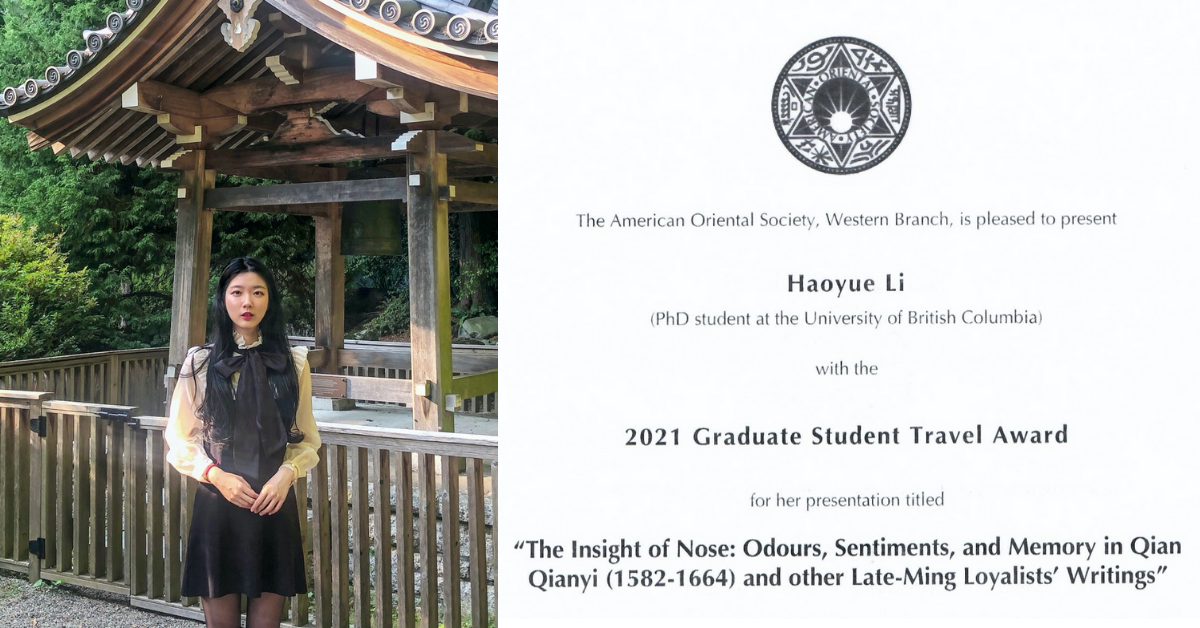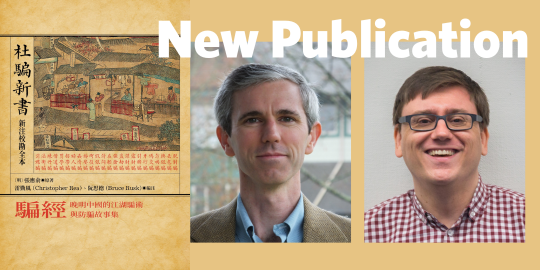Congratulations to Asian Studies doctoral student Haoyue Li, who recently received one of three Graduate Student Awards for her paper “The Insight of Nose: Odours, Sentiments, and Memory in Qian Qianyi (1582-1664) and other Late-Ming Loyalists’ Writings.” Haoyue received US$250 (CAD$310) and presented her research at the American Oriental Society Western Branch 2021 Conference, held the weekend of October 23rd.


Read on for insight into Haoyue’s research and writing process.
Q: Tell us more about your interest in odours.
Haoyue: After first noticing the distinct use of “odour imageries” (e.g., fragrant winds, incense clouds, and fragrant candles) in a seminar class centred on the theme of “ghosts” in pre-modern Chinese writings, I have spent the past three years researching the phenomenon of odours in late imperial (ca. 14th – 19th century) Chinese writings. What can odours tell? How might odour-related phenomena – not just the study of “odour imageries” but also the ways in which historical figures placed olfactory sensations in the sensory spectrum – allow us to reconsider the functions and meanings of odours?
Q: How does this subject matter relate to your research focus?
Haoyue: My fascination with odours, olfactory sensations, and odour narratives led me to the completion of my Master’s thesis, “Reading the Novel through Odours: An Investigation into Chinese Olfactory Aesthetics Using The Story of the Stone as a Case Study” (2019; 120 pages). During the early stages of searching out primary texts for my MA thesis, I came across an abundance of late imperial Chinese prose works and manuals centred on the histories of incense-making, scent-connoisseurship, and genealogies of the moral-political connotations of “odour imageries” in the Confucian literati tradition. This later led me to finish two related research papers after embarking on my PhD journey, and at last this particular conference paper, “The Insight of Nose: Odours, Sentiments, and Memory in Qian Qianyi (1582-1664) and other late-Ming Loyalists’ Writings.”
This conference paper is more like a continuation of my earlier research interests, but this time around I situated the odour phenomenon into the context of the Ming yimin 遺民 (remnant subject/loyalists to a fallen dynasty) writings, with a particular focus on the moral-political connotations of odour imageries, the intertwined relationship between the “literariness” and “materiality” of scents, and mid and late-Ming scent connoisseurship culture.
Q: What are you working on now?
Haoyue: As I move forward in my doctoral program, I intend to continue exploring the odour phenomenon in the late imperial Chinese socio-cultural milieu. The dissertation aims to further situate late imperial Chinese odours phenomena into a broader framework of literary studies and sensory studies, connoisseurship culture and material culture, and the study of medical epistemology and technological history.
About AOS and the 2021 AOS Western Branch Annual Meeting
“The American Oriental Society is the oldest learned society in the United States devoted to a particular field of scholarship. The Society was founded in 1842, preceded only by such distinguished organizations of general scope as the American Philosophical Society (1743), the American Academy of Arts and Sciences (1780), and the American Antiquarian Society (1812). The Western Branch of the AOS was founded in 1951, and its annual meetings have become an important forum for scholars of pre-modern Asia.”
About the Graduate Student Award
In order to encourage graduate students to engage in the activities of the Western Branch, the society in 2015 created the “Graduate Student Travel Award of American Oriental Society, Western Branch.” This year, three awards were offered. Awardees are also honored by special recognition during the conference and on the society’s website.


